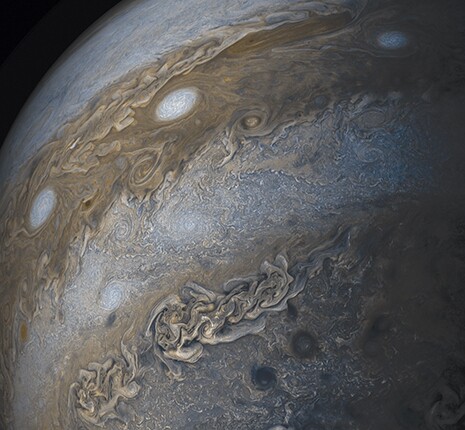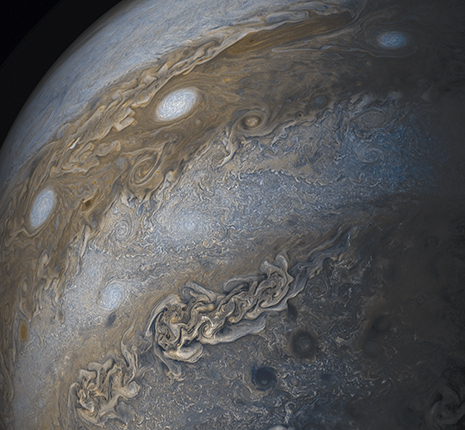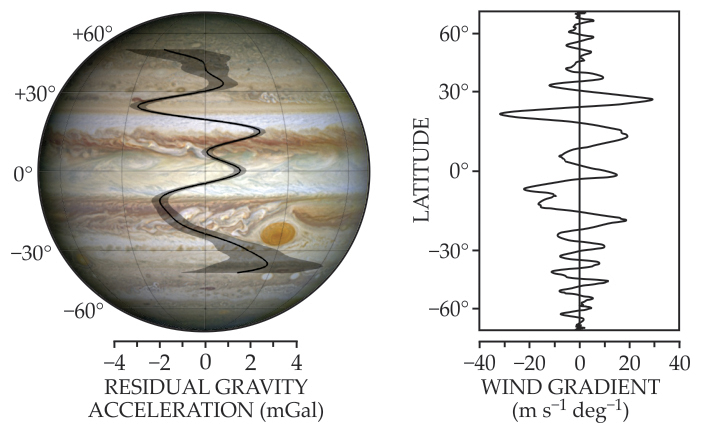Jupiter’s wind bands have deep roots
DOI: 10.1063/PT.3.3914
All four of our solar system’s gas giants sport stripes. Jupiter’s bands, the most prominent, offer even amateur astronomers a stunning view of the planet’s complex atmospheric dynamics. Planetary scientists are especially intrigued by the areas between the stripes, where east–west winds whip clouds around the planet at up to 150 m/s.
For decades researchers have debated the depth of Jupiter’s jet streams, or zonal jets. Some argued that the winds persist only tens or hundreds of kilometers beneath the visible cloud layer. In their view, Jupiter was a giant, uniformly rotating body topped with a razor-thin tier of atmospheric action. Others maintained that the jets stretch much deeper as part of a rich, complex atmosphere, perhaps sustained by heat from the Jovian interior.
Now, a year and a half after settling into orbit around Jupiter, NASA’s Juno spacecraft has resolved the debate. 1 Precise gravimetry measurements reveal that Jupiter’s winds stretch relatively deep into the planet, plunging up to 3000 km beneath the colorful cloud tops. 2 Beyond that depth, Jupiter’s magnetic field takes over and forces the pressurized, conductive hydrogen in the interior to rotate uniformly. 3 The results solve an important puzzle about Jupiter’s structure and could provide a blueprint for profiling other gas worlds in and beyond the solar system.
Odds and evens
The air in Jupiter’s light-colored stripes is at relatively high pressure; the dark stripes are regions of low pressure. Those pressure differences, combined with Jupiter’s rotation, cause the roughly two dozen zonal jets to alternate easterly and westerly directions. The jets are not just mirror images of each other. Jets in the northern hemisphere tend to be stronger, particularly in the vicinity of 24° N latitude, where the planet’s fiercest cloud-top winds have been recorded. The southern hemisphere is a bit calmer, perhaps contributing to the presence of most of the famous long-lived Jovian storms, including the String of Pearls cluster shown in figure
Figure 1.

Jupiter’s active atmosphere, in an enhanced-color image from NASA’s Juno spacecraft. The planet’s bands of dark and light clouds support powerful zonal winds and long-lived storms like those in the so-called String of Pearls (white ovals).
NASA/JPL-CALTECH/SWRI/MSSS/GERALD EICHSTÄDT/SEÁN DORAN

For theorists trying to determine the mechanism that drives the zonal jets, the hemispheric asymmetry rules out the simplest models, which makes the question of depth all the more important to answer. Fortunately, the north–south differences also open up a means of determining the jet streams’ vertical reach. Winds that stretch deep into the planet would presumably transport a significant amount of mass. And because the winds blow differently in the north than in the south, the density profiles of the two hemispheres should be distinct.
To probe Jupiter’s mass profile, mission scientists led by Luciano Iess at the Sapienza University of Rome used Juno as a free-falling test particle in the planet’s gravitational field. During close approaches in December 2016 and May 2017, the spacecraft received radio signals from an antenna on Earth and retransmitted them. Subtle tugs on the probe over the course of its polar orbit were detected via Doppler shifts in the signals received at Earth.
The researchers calculated a series of harmonic functions to describe how the Jovian gravitational field deviates from that of a perfectly spherical mass distribution (see the article by Tristan Guillot, Physics Today, April 2004, page 63
If Jupiter wore only a thin outer layer of atmospheric turbulence, then the even harmonics would tell nearly the whole story. But Juno’s drifting revealed more at play. Mission scientists measured substantial odd harmonics, which reflect asymmetry in mass distribution between Jupiter’s northern and southern hemispheres. As shown in figure
Figure 2.

Gravitational-field anomalies due to mass redistribution by Jupiter’s atmospheric winds, in milligals (0.01 mm/s2). The graph on the left, which is superimposed on a Hubble Space Telescope image of the planet, depicts the gravitational deviations from spherical symmetry, by latitude, that are unrelated to Jupiter’s flattened shape. As shown in the graph on the right, those deviations are the result of mass redistribution by the planet’s powerful zonal winds; the wind gradient is measured as the change in easterly wind velocity per degree latitude. (Adapted from ref.

At 4% of the planet’s mean radius, 3000 km may not seem all that impressive. Yet at that depth, the pressure approaches 105 atmospheres. As pressure increases, so does the electrical conductivity of hydrogen and thus its susceptibility to Jupiter’s potent magnetic field. In theory, that should cause Jupiter’s innards to rotate as if they were a single rigid body. The mass distribution implied by the even harmonics, which are largely unaffected by atmospheric dynamics, supports that picture.
Comparative planetology
Planetary scientists expect to uncover more complexities in Jupiter’s wind profile as Juno continues collecting data. For example, the researchers assumed in their model fitting that the speeds of the jet streams decay exponentially with depth. But data from telescopes and NASA’s Galileo mission in the 1990s suggest that winds can strengthen, weaken, and even shift directions as a function of altitude beneath the cloud tops.
Still, the successful resolution of the deep-versus-shallow debate is a key step toward deciphering Jupiter’s overall structure. The finding suggests that convection powered by Jupiter’s internal heating is central to the winds observed at the cloud tops. Fluid dynamicists can refocus their laboratory simulation and numerical work on devising new models or refining enduring ones, including a 1976 proposal that posits a series of nested rotating cylinders within Jupiter that manifest as jets on the planet’s exterior. 4 The findings that emerge could aid researchers studying not only Jupiter but also Saturn, Uranus, Neptune, hot Jupiter–like exoplanets, and even brown dwarfs, which are intermediate in mass between the heaviest gas giants and the lightest stars.
Preliminary gravity measurements of Saturn, however, suggest that the lessons of Jupiter are not universal. In mid 2017 the Cassini spacecraft executed 22 tight orbits around the ringed giant before taking a final plunge; six of those “grand finale” passes were dedicated to gravimetry.
In a set of papers accepted by Science but not yet published, Iess and other Cassini mission scientists report that Saturn’s jet streams stretch deeper than Jupiter’s. That makes sense, since the pressure of Saturn’s atmosphere builds up more slowly with depth than Jupiter’s. But the odd harmonics of Saturn’s gravitational field seem to defy the exponential decay model of the zonal winds, and the even harmonics don’t jibe with the idea of a uniformly rotating interior. “Some people thought that once you know Jupiter, you know Saturn,” Iess says. “That’s proving not to be the case. Now we have a unique chance to do comparative planetology.”
References
1. L. Iess et al., Nature 555, 220 (2018). https://doi.org/10.1038/nature25776
2. Y. Kaspi et al., Nature 555, 223 (2018). https://doi.org/10.1038/nature25793
3. T. Guillot et al., Nature 555, 227 (2018). https://doi.org/10.1038/nature25775
4. F. H. Busse, Icarus 29, 255 (1976). https://doi.org/10.1016/0019-1035(76)90053-1
More about the Authors
Andrew Grant. agrant@aip.org
